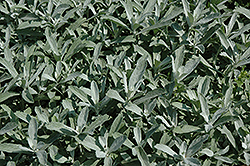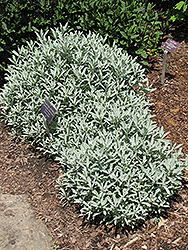Silver King Artemisia
Artemisia ludoviciana 'Silver King'
Height: 32 inches
Spread: 3 feet
Sunlight:
![]()
Hardiness Zone: 2
Other Names: Wormwood, Sage, Mugwort
Description:
Attractive fragrant silver foliage are showcased on this variety; heavily spreading and quite invasive, will take over garden beds and borders without heavy pruning and maintenance
Ornamental Features
Silver King Artemisia's attractive serrated narrow leaves emerge silver in spring, turning gray in color throughout the season on a plant with a spreading habit of growth.
Landscape Attributes
Silver King Artemisia is a dense herbaceous perennial with a ground-hugging habit of growth. Its medium texture blends into the garden, but can always be balanced by a couple of finer or coarser plants for an effective composition.
This is a high maintenance plant that will require regular care and upkeep, and can be pruned at anytime. Deer don't particularly care for this plant and will usually leave it alone in favor of tastier treats. Gardeners should be aware of the following characteristic(s) that may warrant special consideration;
- Spreading
- Invasive
Silver King Artemisia is recommended for the following landscape applications;
- Mass Planting
- General Garden Use
- Groundcover
- Naturalizing And Woodland Gardens
Planting & Growing
Silver King Artemisia will grow to be about 32 inches tall at maturity, with a spread of 3 feet. Its foliage tends to remain dense right to the ground, not requiring facer plants in front. It grows at a medium rate, and under ideal conditions can be expected to live for approximately 10 years. As an herbaceous perennial, this plant will usually die back to the crown each winter, and will regrow from the base each spring. Be careful not to disturb the crown in late winter when it may not be readily seen!
This plant should only be grown in full sunlight. It prefers dry to average moisture levels with very well-drained soil, and will often die in standing water. It is considered to be drought-tolerant, and thus makes an ideal choice for a low-water garden or xeriscape application. It is particular about its soil conditions, with a strong preference for clay, alkaline soils, and is able to handle environmental salt. It is highly tolerant of urban pollution and will even thrive in inner city environments. This is a selection of a native North American species. It can be propagated by division; however, as a cultivated variety, be aware that it may be subject to certain restrictions or prohibitions on propagation.

